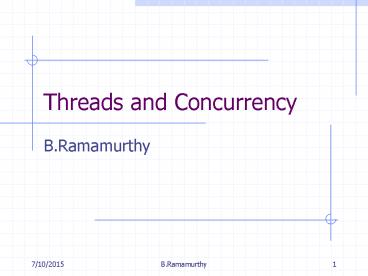Threads and Concurrency - PowerPoint PPT Presentation
Title:
Threads and Concurrency
Description:
Threads and Concurrency B.Ramamurthy Thread Unit of work A process has address space, registers, PC and stack (See man fork for the detailed list) A thread has ... – PowerPoint PPT presentation
Number of Views:111
Avg rating:3.0/5.0
Title: Threads and Concurrency
1
Threads and Concurrency
- B.Ramamurthy
2
Thread
- Unit of work
- A process has address space, registers, PC and
stack (See man fork for the detailed list) - A thread has registers, program counter and
stack, but the address space is shared with
process that started it. - This means that a user level thread could be
invoked without assistance from the OS. This low
overhead is one of the main advantages of
threads. - If a thread of a process is blocked, the process
could go on. - Concurrency Many threads could be operating
concurrently, on a multi threaded kernel. - User level scheduling is simplified and realistic
(bound, unbound, set concurrency, priorities
etc.) - Communication among the threads is easy and can
be carried out without OS intervention.
3
Thread requirements
- An execution state
- Independent PC working within the same process.
- An execution stack.
- Per-thread static storage for local variables.
- Access to memory and resources of the
creator-process shared with all other threads in
the task. - Key benefits less time to create than creating a
new process, less time to switch, less time to
terminate, more intuitive for implementing
concurrency if the application is a collection of
execution units.
4
Examples of thread usage
- Foreground and background work Consider
spreadsheet program one thread could display
menu and get response while another could be
processing the request. Increases the perceived
speed of the application. - Asynchronous processing Periodic backup
(auto-saving) of RAM into disk. A thread could
schedule itself to come-alive every 1 minute or
so to do this saving concurrently with main
processing. - Speed execution In hard-core data-processing
simple concurrency can speed up process. - Transaction processing Many independent
transactions can be modeled very nicely using
threads. Such applications as neural networks,
searches, graphics, agent/actor model suit well
for thread-implementation.
5
Multithreading
- Multithreading refers to the ability of the
operating system to support multiple threads of
execution within a single process. - A process is defined as the unit of protection
and the unit of resource allocation. It has a
virtual address space, protected access to
processors, IPC, files, IO resources.
6
Threads and Processes
- A thread is a unit of work to a CPU. It is strand
of control flow. - A traditional UNIX process has a single thread
that has sole possession of the processs memory
and resources. - Threads within a process are scheduled and
execute independently. - Many threads may share the same address space.
- Each thread has its own private attributes
stack, program counter and register context.
7
Threads and Processes
8
Thread Operations
- Basic Operations associated with a thread are
- Spawn newly created into the ready state
- Block waiting for an event
- Unblock moved into ready from blocked
- Finish exit after normal or abnormal
termination.
9
Issues
- When a thread blocks should the process
associated with it blocked? - Do we need different types of threads for process
context and kernel context? - Should a thread be bound to a processor? If so,
when? - How about daemon threads ? Just like zombie
processes? - Thread scheduling user level control?
- How many concurrent threads?
- How about thread synchronization?
10
User-level Threads
- User Level Threads (ULTs) concept is supported by
a thread library. - All the thread-related operations are supported
by the library creating, destroying, passing
messages, scheduling, saving and restoring
contexts. - An OS may support only ULT
11
POSIX threads standard
- There are two main UNIX thread interfaces
- IEEE Portable Operating System Interface (POSIX)
standard P1003.1c - UNIX International (UI) threads standard.
- Both have the same basic model of threads, though
the actual function tend to use different styles. - We will use POSIX standards.
12
Thread Control
- Thread creation (create, run, join, kill)
- Thread schedule (yield)
- Thread synchronization (mutex, barrier)
- Code for execution

